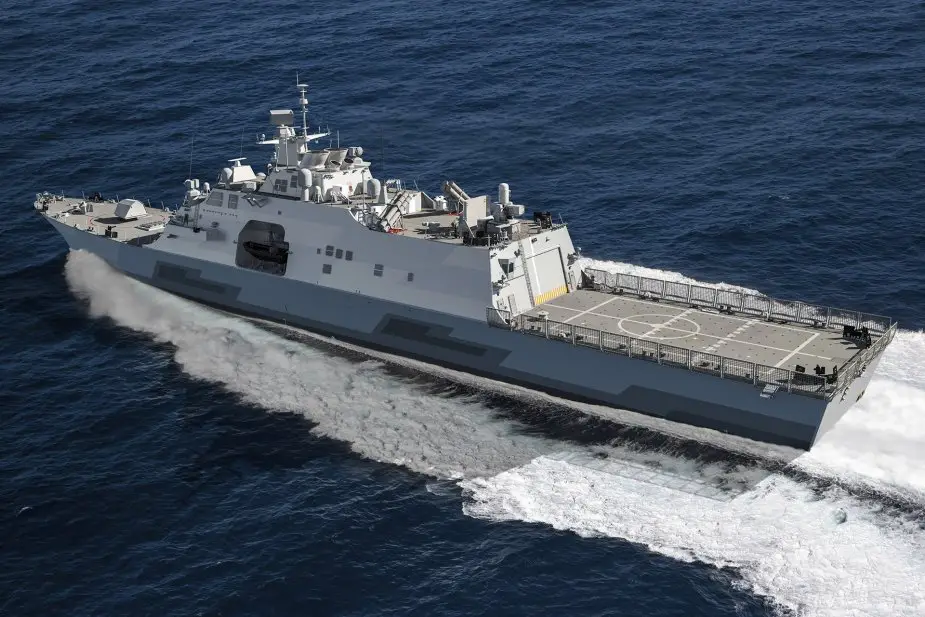According to information published by Seapower Magazine on May 18, 2021, the Greek government and the United States are discussing now the future acquisition of four frigates by the Greek Navy amid the current tensions with his neighbor, Turkey. The US offer will be based on the Multi-Mission Surface Combatant (MMSC).
Follow Navy Recognition on Google News at this link
 Artist rendering of the MMSC (Picture source: Lockheed Martin)
Artist rendering of the MMSC (Picture source: Lockheed Martin)
The Multi-Mission Surface Combatant (MMSC) is a lethal and highly maneuverable multi-mission surface combatant capable of littoral and open-ocean operation. It was designed from the keel-up to confront modern maritime and economic security threats.
The MMSC takes the proven capabilities of the U.S. Littoral Combat Ship and the inherent flexibility of the Freedom-variant hull to meet the unique maritime requirements of international navies. The Multi-Mission Surface Combatant has a range of 5,000 nautical miles and can reach speeds in excess of 30 knots. It will be based on the Freedom-variant Littoral Combat Ship’s 118-meter hull and it will utilize the same combined diesel and gas propulsion system.
With proven combat management system lineage, Lockheed Martin’s MMSC has the interoperability necessary for today’s joint and allied naval force maneuvers. Paired with the world’s most advanced maritime helicopter, the MH-60R SEAHAWK®, the MMSC will have a robust anti-submarine mission capability that is fully interoperable with the U.S. Navy and its coalition partners.
The MMSC utilizes the COMBATSS-21 Combat Management System, built from the Aegis Combat System Software library. The MMSC integrated combat system solution leverages the domestic LCS integration of the 57mm Mk110 deck gun and SeaRAM, and expands multi-mission capability through integration of Over-The-Horizon surface-to-surface missiles, port and starboard 20 mm remote guns, a new fire control radar and a forward centerline 8 cell MK 41 Vertical Launch System equipped with RIM-162 Evolved Sea Sparrow Missiles. The MMSC is also equipped with the AN/SLQ-25 Torpedo Defense system.
Operational and deployed today with the U.S. Navy as the primary anti-submarine warfare anti-surface weapon system for open ocean and littoral zones, the MH-60R SEAHAWK helicopter is an advanced maritime helicopter. It is a naval helicopter available today designed to operate from frigates, destroyers, cruisers and aircraft carriers.
The Freedom-class is one of two classes of the littoral combat ship program, built for the United States Navy.
The design of Freedom-class is based on a semi-planing steel monohull with an aluminum superstructure. She has a length of 377 ft (115 m), and displaces 3,500 metric tons (3,400 long tons). The design also incorporates a large, reconfigurable sea frame to allow rapidly interchangeable mission modules, a flight deck with an integrated helicopter launch, recovery, and handling system, and the capability to launch and recover boats (manned and unmanned) from both the stern and side.
The Freedom-class is powered by two Rolls-Royce MT30 36MW gas turbines and two Colt-Pielstick 16PA6B 6.8 MW (9,100 hp) diesel engines and 4 Rolls-Royce waterjets. She can reach a top speed of 47 knots (87 km/h; 54 mph) with a maximum cruising range 3,500 nmi (6,500 km; 4,000 mi) at 18 knots (33 km/h; 21 mph).
The Mark 41 Vertical Launching System (Mk 41 VLS) is a shipborne missile canister launching system that provides a rapid-fire launch capability against hostile threats. The Vertical Launch System (VLS) concept was derived from work on the Aegis Combat System.



